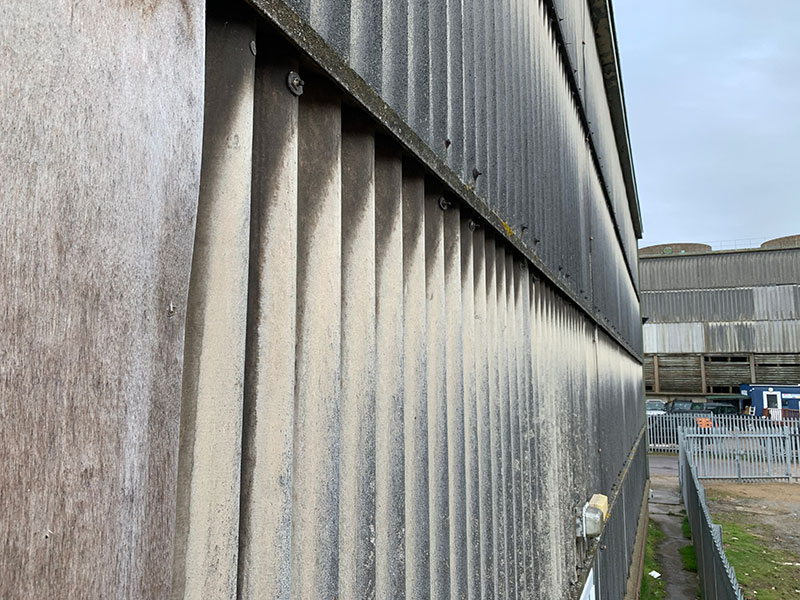What is asbestos cement and how can you identify it?
When most of us hear the term “asbestos” today, we are generally put in mind of the fact that this now-banned mineral is an extremely dangerous carcinogen. This reality became apparent over the course of the 20th century, as a link was gradually discovered between exposure to this supposed “wonder material” and the development of certain serious (and frequently fatal) health conditions.
Today, the situation is drastically different; it has not been legal to import or use any type of asbestos in the UK since 1999. This marks quite the contrast from the days when asbestos was extensively used across such industries as construction and shipbuilding.
However, during the time when asbestos was widely used in the UK, one of the most common asbestos products was asbestos cement. This term is used in reference to the then-frequent practice of mixing chrysotile asbestos (also known as “white” asbestos) with regular cement.
Asbestos cement was used to produce the likes of asbestos cement roof sheeting, wall cladding, downpipes, gutters, cement flues, and even water and sewage pipes.
Although the 1999 ban on asbestos in the UK prevented the substance’s future use in construction, it did not bring about any automatic requirement for asbestos to be removed from buildings where it was already present.
So, at premises where asbestos cement products such as roof sheets remain in place, certain risks may be presented to building managers, occupants, and contractors alike. This, in turn, underscores the potential importance of engaging the services of experts in the identification and removal of asbestos cement.

What does asbestos cement look like?
Asbestos typically makes up about 10% to 15% of asbestos cement, although in some cases, it may constitute over a third of the cement. Nonetheless, given that traditional cement accounts for most of asbestos cement, it is common for this product to look like “normal” cement to the naked eye, being hard and light or dark grey in colour.
However, there can still be a few visual giveaway signs of a given cement product possibly being asbestos cement. If one looks closely at the material, it is sometimes possible to see the white asbestos that has been mixed in. So, a white-and-grey look could be an important indicator.
The “wavy” appearance of asbestos corrugated roof sheets has also long been a familiar sight in the UK. However, it should be emphasised that even this “waviness” cannot be taken as definitive confirmation of a roof sheet containing asbestos. This can only be determined for sure by having the material undergo laboratory testing.
How can you identify asbestos cement?
To reiterate: you should never depend on visual inspection alone as a means of confirming whether a particular material does or doesn’t consist of asbestos. This is no less the case when you are examining products that you suspect may contain asbestos cement.
By reaching out to a professional, you can determine whether asbestos is present in a given product in your building, followed by receiving recommendations on how to manage it.
If you have a “duty to manage” asbestos at your premises in accordance with Regulation 4 of the Control of Asbestos Regulations 2012 (CAR 2012), you will need to take reasonable steps to determine whether there are asbestos-containing materials (ACMs) on the site. If they are indeed present, you will need to find out their location, amount, and condition.
A professional asbestos survey will enable you to fulfil this duty if your building dates from before the year 2000. There are two types of asbestos survey – a management survey and a refurbishment or demolition survey. It is a management survey that you will need to arrange if you are looking to manage ACMs during the normal occupation and use of the premises.
Whichever type of asbestos survey you arrange, it is likely to involve sampling. You can therefore expect the asbestos surveyor on your site to collect a sample of your suspected asbestos cement product. This will then be sent to a laboratory, so that it can be scrutinised by suitably trained and competent analysts.
After completion of the surveying and analysis, you can expect to be issued with a comprehensive asbestos report. This will provide in-depth information about the asbestos situation at your property, including confirmation of whether the suspected asbestos cement material does or doesn’t contain the now-banned mineral.
Where is asbestos cement commonly found in homes?
For much of the 20th century, asbestos cement was moulded and compressed to create a variety of products that continue to be present in many domestic properties up and down the UK.
These include the likes of:
- Roofing materials, such as the once-ubiquitous corrugated sheets
- Wall cladding and partitions, which largely resemble asbestos cement roof sheeting, but may be flat; they are often found in buildings that have asbestos cement roofing
- Gutters and downpipes, frequently attached to the end of asbestos cement roofs
- Water tanks, often installed inside lofts and other indoor locations
- Flue pipes, associated with old domestic type boilers that are also likely to contain asbestos
As the above list shows, there is considerable scope for asbestos cement to be present around both indoor and outdoor areas of a UK residential property that was constructed or renovated prior to the 1999 ban.
We mentioned above that asbestos was once perceived as a “wonder material”, in the days before its severe dangers to health became well-known.
The fibrous silicate mineral was affordable, easily available, physically strong, and fire-resistant, in addition to mixing well with concrete. The embedding of asbestos fibres into a concrete mix also helped create a structure or surface that was relatively resistant to cracking.
White asbestos – the type of asbestos typically used in asbestos cement – was not banned in the UK until 1999. “Blue” and “brown” asbestos – otherwise known as crocidolite and amosite asbestos respectively – were less frequently used in asbestos cement, and the importation of these forms of asbestos into the UK had been outlawed earlier, in 1985.
How dangerous is asbestos cement?
Compared to some other ACMs, such as asbestos insulating board (AIB), asbestos cement is a well-bonded material believed to pose a lower risk to health. In the event of the asbestos cement being damaged, while the material will release asbestos fibres, these levels of release will generally be lower than would be the case for AIB that is similarly damaged.
However, it is also of critical importance to emphasise that no level of asbestos exposure can be considered “safe”. The reality is that disturbed or damaged asbestos cement can still present a very serious risk to health.
If asbestos fibres are, indeed, released from asbestos cement at your property, and someone nearby subsequently breathes in these particles, they could be at elevated risk of developing a potentially fatal asbestos-related disease later in life.
Asbestos exposure is linked to health conditions such as asbestosis and mesothelioma. Indeed, even in the 2020s – more than two decades since the ban – approximately 5,000 people die from asbestos-related disease every year in the UK.
Another crucial factor to bear in mind, is that even the “youngest” asbestos cement products in UK buildings are now several decades old. Asbestos cement becomes brittle as it ages. This, along with such factors as the general condition of the material and whether it is in a location where disturbance is likely, could drive up the health risk the material presents over time.
Do you need a licence to remove asbestos cement?
Work on asbestos cement is generally considered to pose a lower risk than the treatment of some other asbestos materials. For this reason, asbestos cement can often be removed by someone who does not hold a licence from the UK Health and Safety Executive (HSE). However, a contractor who carries out such work should still have received training enabling them to recognise and work safely with asbestos.
In summary, a HSE licence will not be required for the removal of asbestos cement such as roof sheeting, provided that the material is carefully handled and removed without breaking up. This includes work with asbestos cement which is weathered but has not otherwise been substantially damaged.
Having said all the above, to repeat advice we have often given here at Oracle Solutions: even if a HSE licence isn’t strictly required in order for certain asbestos removal work to be carried out at your property, it may be best that you seek out a licensed contractor regardless.
A licensed asbestos removal contractor, after all, is a contractor that the HSE has judged to be competent and knowledgeable enough to handle all asbestos remediation work. Choosing such a contractor, then, could give you the peace of mind of knowing that the job will be done safely by a trustworthy and skilled professional.
Conclusion: asbestos cement necessitates expert identification and management
With asbestos cement often being barely visually distinguishable from traditional cement that does not contain asbestos, it is of the utmost importance that you do not depend on sight alone to identify any possible asbestos cement products at your property.
By arranging for a professional asbestos survey and laboratory testing to confirm whether a suspect material is or isn’t asbestos, followed by acting on the surveyor’s recommendations in how you manage the material, you can help ensure both safety and legal compliance.
To discuss any asbestos-related concerns that you may have in relation to your property, including ahead of any retrofitting projects, please don’t hesitate to contact our experts at Oracle Solutions today.

Written by Callum McDonald
Callum McDonald is an expert in asbestos quality management, ensuring rigorous adherence to regulations and high-quality standards in removal projects. His focus on enhancing quality and client satisfaction makes him a crucial asset in safety and compliance within the field. Callum's expertise in technical support and oversight of licensed works underscores his commitment to excellence in asbestos management, providing invaluable guidance to clients in this specialised area.
